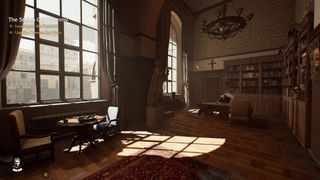Alan Wake 2 appeared so late last year that you'd be forgiven for thinking that it was a 2024 launch. You'd also be forgiven for believing that its outstanding visual design and use of ray tracing would be a standard consistently achieved this year. Alas, for everything that I've seen and analysed these past 12 months, Remedy's masterpiece is still the bar that others have failed to reach.
That isn't to say that there haven't been some fantastic technical achievements this year. Dragon's Dogma 2 launched in March but despite being a great game, its excessive hardware requirements, inconsistent performance, and last-gen graphics didn't exactly kick things off with a bang. Fortunately, that disappointment in that game was countered by Nixxes Software's port of Horizon Forbidden West.

As the original game never used ray tracing, the developers sensibly chose to not make any attempt to integrate it in the conversion. Instead, it focused on improving the fundamental assets, as well as implementing upscaling and frame generation to boost performance, rather than offset any heavy-handed rendering technology.
The game might not be to everyone's taste and it's not as good as the first Horizon Zero Dawn, but in terms of technical achievement, Nixxes knocked it out of the park.
The same was true of another PlayStation port, Ghost of Tsushima in May, which—surprise, surprise—was another Nixxes project. No ray tracing, just good ol' traditional rendering done well. Admittedly, when it comes to surface reflections, once you've seen what ray tracing can do in this aspect, going back to screen space reflections just feels yuck.

By June, I was beginning to wish that Nixxes was responsible for every console-to-PC port because we were 'treated' to Shadow of the Erdtree, Elden Ring's first expansion. Having only briefly played the first game I'd completely forgotten what a mess it was on the PC and had even assumed that the new content would include an update to the engine. That wasn't the case and once again, stutters and an ever-present lag would be there for PC gamers to enjoy.
The first 2024 games to heavily feature ray tracing took a while to make an appearance, but in August, Black Myth: Wukong and Star Wars Outlaws were the first big releases to be ray-traced only. Not the first games ever, mind, but you get what I mean.
Wukong uses Unreal Engine 5, whereas Outlaws runs on the same engine as Avatar: Frontiers of Pandora, but both exhibited the most common traits of the year: Variable performance, traversal stutter, interminable shader compilation, and an almost necessary use of upscaling to achieve any semblance of a decent frame rate.

At least one could say that on maximum settings with Full Ray Tracing (aka path tracing) enabled, Wukong's visuals justified the performance. That's not something that could be said for Outlaws, though it does run a lot better now after several patches.
While it is simpler for developers to just focus on one rendering pipeline, I feel that we're still at least one generation of GPUs away from ray tracing being the acceptable norm for games to use exclusively.
Not everything this year has been a janky mess. In September, PC gamers could enjoy an incredible port of God of War Ragnarök (and by the original developers, no less) and Warhammer 40K: Space Marine 2 ran very well for a game with hundreds of enemies to battle against. Neither were a tour-de-force in terms of graphics but they were good enough.

'Good enough' is probably the phrase that the developers of the Silent Hill 2 remake sarcastically said after finishing its PC version because while that's been one of my favourite games of 2024, it's a shocking mess on the humble PC.
For example, I had to copy one file from a folder in the game's installation and paste it into the main folder just so it would start. Then I had to deal with so many visual glitches and frame rate jank that I genuinely thought I was playing a beta release. It's a superb remake and worthy of all its acclaim, but I have little praise for the PC conversion.
The technical terrors continued as the weeks rolled on: Microsoft Flight Simulator 2024 refused to work for over a week after launch and Stalker 2: Heart of Chornobyl looked great, and played great, but ran like it had a chronic case of hiccups (Unreal Engine 5 strikes again).

Cue patches, more patches, and even more patches. In the case of Stalker 2, you're looking at over half a terabyte's worth of downloads, just in the form of patches. Maybe I should be writing about the Best Patch of 2024.
Anyway, to be fair, both games aren't too bad on a high-end gaming PC but anything sporting hardware at the bottom end of the system requirements is going to require every ounce of upscaling and frame generation to run smoothly.
Given all that had transpired, I had few hopes for Indiana Jones and the Great Circle, especially when I learned that it would always be using ray tracing, as well as having a path tracing mode. Sorry, Full Ray Tracing. Well, glaze me in honey and call me Susan, how wrong I was.

Well, mostly wrong. Great Circle runs pretty well, even on low-end hardware (though the GPU must have ray tracing hardware), and if you can get the Full Path Tracing mode to run nicely, then it's almost as impressive as Alan Wake 2. And it's packed with lots of nice touches, such as the way the game loads a previous save as the main menu. Sadly, it is pretty glitchy and it's taken a few patches to make frame generation work as intended.
At least it wasn't another Unreal Engine 5 game but anyone expecting Doom Eternal levels of performance just because it uses the ID Tech 7 engine is in for a shock. The game itself is a huge amount of fun, at least, and looks pretty darn nice.
PC Gamer 2024 Game Performance Analysis
Looking ahead to the first half of 2025, we've got some big games incoming that are going to sport cutting-edge graphics: Marvel's Spider-Man 2, Final Fantasy VII Rebirth, Civilization 7, Kingdom Come: Deliverance 2, Assassin's Creed: Shadows, The Last of Us Part 2, to mention but a few.
If any of them are going to do really well on PC, I hope the developers have looked carefully at what's gone right and what's gone poorly with this year's releases.
Always-on ray tracing isn't necessarily a bad thing but shoehorning in an all-singing path tracing mode just seems to be a recipe for disaster at the moment, as so few GPUs can really handle it. But even with traditional rendering techniques, it's still possible to end up with a stuttery, unplayable mess and relying on upscaling and frame generation to mask such issues isn't acceptable.
Alan Wake 2 gave me such hope for 2024 that I feel somewhat cheated by what I actually got this year, but a few gems did show up. And if those developers could do it, I'm sure others can too. Here's to 2025 and let's hope it's a good one.

 1 week ago
4
1 week ago
4









 English (US) ·
English (US) ·